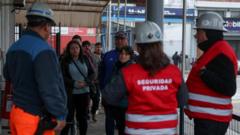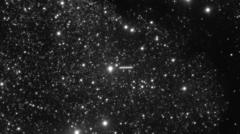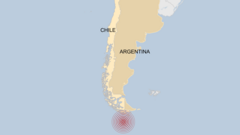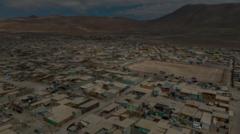With unprecedented capabilities, this telescope promises to reveal the mysteries of dark matter and the cosmos, forecasting a new era of astronomical discovery.
Revolutionary Telescope Unveils First Celestial Images, Transforming Astronomy
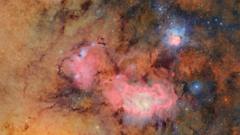
Revolutionary Telescope Unveils First Celestial Images, Transforming Astronomy
The Vera C. Rubin Observatory's initial images showcase the depths of the universe from Chile, igniting excitement in the scientific community.
The Vera C. Rubin Observatory in Chile has marked a significant milestone in the field of astronomy by unveiling its first celestial images, showcasing the remarkable Trifid and Lagoon nebulae in exquisite detail. This highly anticipated event highlights the observatory's unparalleled capacity to explore the intricate depths of the universe. Nestled 9,000 light years away from Earth, the vibrant clouds of gas and dust captured in the images signal the birth of new stars and the beginning of a transformative era in our understanding of celestial phenomena.
The Rubin Observatory, equipped with the world's most powerful digital camera, is set to revolutionize how we view the cosmos. If the rumored ninth planet exists in our solar system, it is anticipated that this telescope will locate it within its first year of operation. Additionally, it is designed to identify potentially hazardous asteroids orbiting near Earth and create an extensive mapping of the Milky Way galaxy. The observatory also aims to resolve pivotal inquiries surrounding dark matter, the elusive component that constitutes a significant part of the universe.
The establishment of this observatory represents a proud moment for many astronomers who have dedicated decades to its conception and construction. Professor Catherine Heymans, the Astronomer Royal for Scotland, expressed her excitement, stating, "I have been working towards this point for about 25 years." The UK's involvement as a primary partner will facilitate the processing of data collected during the observatory's anticipated ten-year survey of the southern night sky.
BBC News had the opportunity to visit the Rubin Observatory prior to the release of the first images. Perched on Cerro Pachón in the serene Chilean Andes, the observatory's location is optimal for celestial observations due to its high elevation, dry climate, and low light pollution. This pristine environment is crucial for capturing precise astronomical data. To maintain the required darkness for observations, strict protocols are enforced, ensuring that any stray lights from vehicles or internal sources are meticulously managed.
The high-tech design of the observatory, particularly its 3,200-megapixel camera—manufactured by the US Department of Energy's SLAC National Accelerator Laboratory—is central to its capabilities. Featuring a unique three-mirror system, the telescope collects vast amounts of light, allowing it to observe celestial bodies from significantly farther distances than ever before. It is said that the camera's impressive resolution could potentially identify an object the size of a golf ball on the Moon.
The telescope will conduct its Legacy Survey of Space and Time, capturing images every 40 seconds nightly for approximately eight to twelve hours. Researchers estimate that the observatory will compile around 10 million data alerts each night, heralding an unprecedented opportunity to study the cosmos. By repeatedly surveying the same regions of the sky, the telescope will detect any transient changes, offering scientists invaluable insights into the dynamic nature of space.
The opportunity to observe transient astronomical events—those that occur sporadically and can sometimes pose risks, such as asteroids straying dangerously close to Earth—promises to be one of the Rubin Observatory’s most significant contributions. With ambitious goals, scientists aim to expand our understanding of the universe's origins, the formation of the Milky Way, and the objects within our solar system.
Professor Alis Deason from Durham University will play a vital role in analyzing the vast datasets generated by the telescope, aspiring to map the furthest reaches of the Milky Way galaxy, potentially extending our observational range from 163,000 light years to an astonishing 1.2 million light years. Furthermore, the observatory might unlock the mysteries associated with Planet Nine, pursuing evolution theories for our solar system and its existence based on data previously unreachable by terrestrial telescopes.
The Vera C. Rubin Observatory stands ready to illuminate the cosmos while heralding a new chapter of astronomical exploration. With its commitment to science and innovation, this observatory promises to enrich our understanding of the universe for generations to come.
The Rubin Observatory, equipped with the world's most powerful digital camera, is set to revolutionize how we view the cosmos. If the rumored ninth planet exists in our solar system, it is anticipated that this telescope will locate it within its first year of operation. Additionally, it is designed to identify potentially hazardous asteroids orbiting near Earth and create an extensive mapping of the Milky Way galaxy. The observatory also aims to resolve pivotal inquiries surrounding dark matter, the elusive component that constitutes a significant part of the universe.
The establishment of this observatory represents a proud moment for many astronomers who have dedicated decades to its conception and construction. Professor Catherine Heymans, the Astronomer Royal for Scotland, expressed her excitement, stating, "I have been working towards this point for about 25 years." The UK's involvement as a primary partner will facilitate the processing of data collected during the observatory's anticipated ten-year survey of the southern night sky.
BBC News had the opportunity to visit the Rubin Observatory prior to the release of the first images. Perched on Cerro Pachón in the serene Chilean Andes, the observatory's location is optimal for celestial observations due to its high elevation, dry climate, and low light pollution. This pristine environment is crucial for capturing precise astronomical data. To maintain the required darkness for observations, strict protocols are enforced, ensuring that any stray lights from vehicles or internal sources are meticulously managed.
The high-tech design of the observatory, particularly its 3,200-megapixel camera—manufactured by the US Department of Energy's SLAC National Accelerator Laboratory—is central to its capabilities. Featuring a unique three-mirror system, the telescope collects vast amounts of light, allowing it to observe celestial bodies from significantly farther distances than ever before. It is said that the camera's impressive resolution could potentially identify an object the size of a golf ball on the Moon.
The telescope will conduct its Legacy Survey of Space and Time, capturing images every 40 seconds nightly for approximately eight to twelve hours. Researchers estimate that the observatory will compile around 10 million data alerts each night, heralding an unprecedented opportunity to study the cosmos. By repeatedly surveying the same regions of the sky, the telescope will detect any transient changes, offering scientists invaluable insights into the dynamic nature of space.
The opportunity to observe transient astronomical events—those that occur sporadically and can sometimes pose risks, such as asteroids straying dangerously close to Earth—promises to be one of the Rubin Observatory’s most significant contributions. With ambitious goals, scientists aim to expand our understanding of the universe's origins, the formation of the Milky Way, and the objects within our solar system.
Professor Alis Deason from Durham University will play a vital role in analyzing the vast datasets generated by the telescope, aspiring to map the furthest reaches of the Milky Way galaxy, potentially extending our observational range from 163,000 light years to an astonishing 1.2 million light years. Furthermore, the observatory might unlock the mysteries associated with Planet Nine, pursuing evolution theories for our solar system and its existence based on data previously unreachable by terrestrial telescopes.
The Vera C. Rubin Observatory stands ready to illuminate the cosmos while heralding a new chapter of astronomical exploration. With its commitment to science and innovation, this observatory promises to enrich our understanding of the universe for generations to come.

